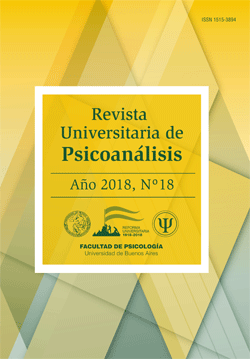Revista Universitaria de Psicoanálisis - Volumen XVIII

Texturas del yo: vacío y consistencia
Textures of the Ego: Void and consistency
Autor/es: Por Diana Algaze1, Verónica Caamaño1, Andrea Pirroni1, Tomasa San Miguel1 y Milagros Scokin1
1Universidad de Buenos Aires (UBA) Facultad de Psicología (UBA). Docente Cátedra II. Psicopatología, Titular Doctor Fabián Schejtman. Facultad de Psicología (UBA)
Investigadora UBACyT.
E- Mail: dianalgaze@gmail.com
RESUMEN
Hacia el final de su enseñanza Lacan propone una lectura del yo en consonancia con sus teorizaciones acerca de la topología y la lógica nodal. Dicha relectura nos permite revisar el estatuto del yo, su constitución y su función en el ser parlante. Quisiéramos, por ello mismo, fundamentar una distinción entre la modalidad que presenta el yo en las neurosis y la constitución del yo, y su funcionamiento, en el parlêtre.
Para ello comenzaremos por articular la relación del yo con el inconsciente para dilucidar si las conceptualizaciones más revisadas en la bibliografía psicoanalítica sobre el yo no apuntan, en general, al modo de funcionamiento del yo en la neurosis. Para ello abordaremos, desde el planteo freudiano, la constitución del yo y su relación con la represión como mecanismo propio de las neurosis y, en función de eso, la constitución de la realidad y del cuerpo.
Luego nos detendremos en las formulaciones freudianas sobre el nacimiento, desarrollo y constitución del yo en su relación al cuerpo y al narcisismo.
Finalmente, intentaremos definir el yo como agujero en lo imaginario, diferenciando los distintos tipos de agujero en el nudo que constituye al ser hablante.
Palabras clave:
Yo - Cuerpo - Represión primaria - Verdadero agujero - Ser hablante.
SUMMARY
Towards the end of his teaching, Lacan proposes a conception of the self according to his theorizations about topology and nodal logic. This rereading allows us to review the status of the self, its constitution and its function in speaking. We would like, therefore, to base a distinction between the form that presents the self in the neuroses and the constitution of the self, and its functioning, in the parlêtre. We believe that it is clinically necessary to move a certain theoretical detour that promotes the conceptualization of the self from a single reading: the self is imaginary and therefore we must avoid dealing with it. What are the consequences that psychoanalysis promotes at a social level under this kind of foreclosure of the self as an ideal of healing? Lacan will say that \\\"the subject is not without his self\\\", and \\\"that psychoanalysis is a practice that deals with that which does not work out, terribly difficult since it pretends to introduce into everyday life the impossible and the imaginary\\\" (Lacan, 1974: p.1).
Keywords:
Self – Knot - Parlêtre -The imaginary
Opción de descarga del trabajo completo en .pdf
Secretaría e Instituto de Investigaciones
Lavalle 2353
Tel/fax:4952 – 5481/ 4952 – 5490
Horario de atención: 10 a 17 hs
E-mail:
instinve@psi.uba.ar


